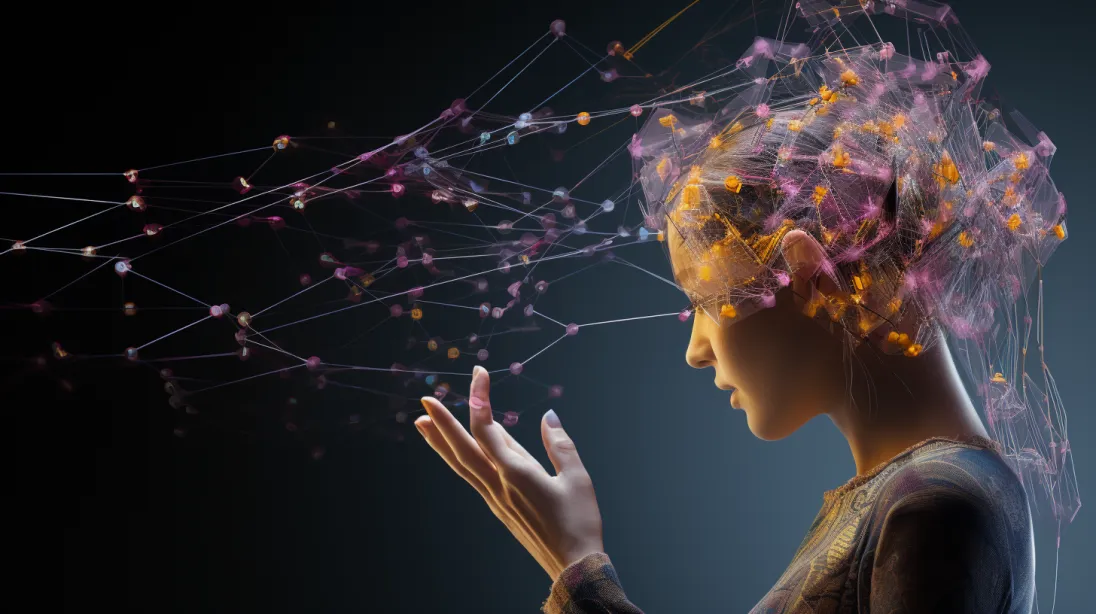Table of Contents
For centuries, humanity has dreamt of bridging the gap between thought and reality, of effortlessly translating the whispers of our minds into tangible expressions. From telepathy in science fiction to cryptic codes deciphered by dedicated codebreakers, the realm of thought-to-text has long captivated our imaginations.
But what if the line between fantasy and reality is blurring? Recent advancements in brain-computer interfaces (BCIs) are tantalizing us with the possibility of transforming our internal monologues into external text, literally turning thoughts into words on a screen.
Unlocking the Mind’s Secrets: The Birth of Thought-to-Text AI
At the forefront of this exciting revolution is “BrainGPT,” a groundbreaking AI system developed by researchers at the University of Technology Sydney. This non-invasive marvel utilizes EEG technology to capture the electrical buzz of our brains, deciphering these neural messages into coherent streams of text. Imagine silently formulating a sentence, and voila! It appears on your screen, birthed from the depths of your mind.
The implications of “thoughts into text” technology stretch far beyond mere novelty. This innovative tool holds the potential to revolutionize numerous facets of our lives:

Empowering Communication: For individuals with speech impairments or paralysis, “thoughts into text” could become a transformative force, granting them autonomy and a powerful voice. Imagine a world where the limitations of physical expression vanish, allowing everyone to share their thoughts, ideas, and experiences with the world. Writers could craft novels solely through the power of their minds, and musicians could compose symphonies by silently humming the melodies in their hearts. Communication barriers would crumble, fostering deeper connections and unlocking unheard voices.
Unleashing Creativity: Artists and creatives could tap into the raw, unfiltered flow of their thoughts, capturing fleeting ideas and inspirations effortlessly. Imagine sculptors molding virtual clay with mere thought or painters wielding brushes dipped in the vibrant palette of their minds. The boundaries between internal imagination and external expression would dissolve, giving rise to a renaissance of artistic expression. Writers could compose poetry directly onto the digital page, and musicians could orchestrate symphonies without needing physical instruments. The limitations of traditional tools would fade away, paving the way for a boundless realm of creative exploration.
Augmenting Learning: “Thoughts into text” technology could personalize learning experiences like never before. Imagine classrooms where knowledge adapts to individual thought patterns and preferences, tailored instruction flows seamlessly from teacher to student, and understanding blossoms within each unique mind. Students could absorb information at their own pace, focusing on areas that resonate with their cognitive strengths. This level of personalized learning could revolutionize education, fostering deeper understanding and unlocking the full potential of every student.
But is it Mind-reading? Not Quite Yet
It’s important to clarify that “thought-to-text” technology, while impressive, doesn’t translate to literal mind-reading. It focuses on decoding specific neural patterns associated with language processing, not the entirety of our complex inner thoughts and emotional landscapes. Privacy concerns remain paramount, and ethical considerations must be carefully navigated as this technology matures.
Related Article
The Future Beckons: Beyond the Buzz of Brainwaves
Despite the challenges, the potential of “thought-to-text” technology is undeniable. Imagine a world where our thoughts find seamless expression, where communication barriers crumble, and where creativity flourishes unhindered. The future whispers on the horizon, pregnant with possibilities, and the technology of turning thoughts into text is merely the first verse in a remarkable chapter yet to be written.
As we continue to explore the intricate workings of the human mind, the line between thought and action is poised to blur further. Who knows, one day, composing a symphony or crafting a groundbreaking scientific theory might require only a silent meditation and a receptive interface. The age of “thought-to-text” dawns, beckoning us towards a future where our minds become both the source and the canvas of our realities.
Expand on the Challenges and Ethics:
- Dedicate a paragraph to the ethical concerns surrounding thought-to-text technology. Explore issues like potential privacy breaches, manipulation of thoughts, and the widening of social inequalities. Discuss ongoing research and initiatives to address these concerns and ensure the responsible development of this technology.
- Briefly mention the technical challenges currently hindering widespread adoption, such as accuracy limitations, dependence on specific brain patterns, and the need for more user-friendly interfaces. Briefly address the ongoing research to solve these problems.
Personalize the Experience:
- Include a section showcasing how individuals from different walks of life might benefit from thought-to-text technology. Imagine a musician composing through mental melodies, a painter visualizing their masterpieces directly onto a canvas, or a student absorbing knowledge through personalized neural pathways. This allows readers to connect with the technology on a personal level.
Spark the Imagination:
- Conclude the blog with a thought-provoking question or a glimpse into the potential future applications of thought-to-text technology. Could it lead to telepathic communication, enhanced AI interaction, or even direct control over physical objects? By igniting the reader’s imagination, you leave them captivated and excited about the possibilities this technology holds.